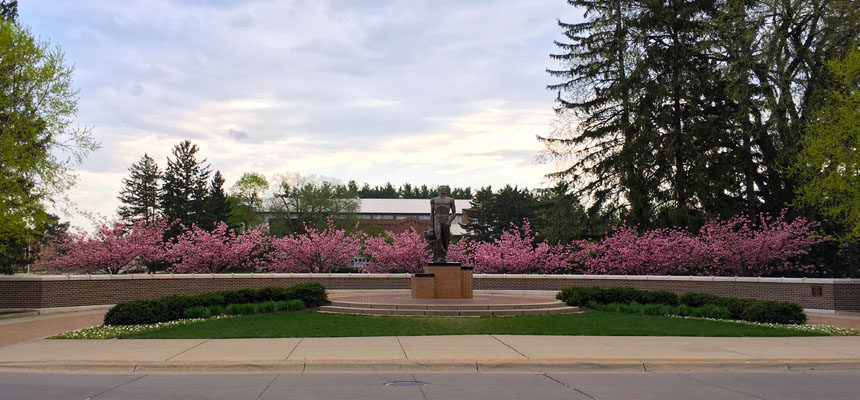Now that we are experiencing more warmer spring weather, there are trees blooming just about everywhere you look throughout Mid-Michigan! As we are approaching mid- to late-spring, the flowering trees are primarily shades of pink and purple, with still some white blooms to break up the color. While these flowering trees are beautiful for us to look at, they are working hard every day to provide pollen and nectar for our local pollinators.
Purple and Pink Flowering Trees
The first tree I want to feature is my favorite spring blooming tree – the Eastern Redbud. What I like about this tree is that its natural flower color is unusual as a true purple bloomer.
Eastern Redbud (Cercis canadensis)
A native tree to the Midwest, this spring bloomer puts on a show of purple flowers along the entirety of its branches, stems and sometimes even on its trunk. It is a beautiful specimen tree, but when it is planted in groupings of three it really shines. In groupings, the flowering stems overlap to double the intensity of the purple cloud that it creates.
Redbud branches have a unique ID characteristic. When you look at the branches of a Redbud, they don’t grow straight like most other tree branches do. Rather, they angle back and forth to create an interesting zig-zag pattern.
There are many cultivars (cultivated varieties, or flavors) of Redbud. Some of them are white or magenta. Others have a weeping form. And still others have purple leaves in the summer instead of the standard green leaves.
Flowering Crabapple (Malus)
While not proven to be a scientific fact, casual observation would indicate that one of the most commonly planted ornamental trees is the Flowering Crabapple. These trees are so popular because of the high impact floral display that they provide reliably every spring. Their 1” diameter, five petal flowers uniformly cover the entire tree and last for several weeks if the weather doesn’t get too hot too fast.
Crabapples come in all shapes, sizes and colors. Their buds and blooms range from pure white to dark magenta, with quite literally everything in between. Crabapples can have green leaves or maroon leaves. Their canopy’s form can be V-shaped, rounded, spreading (think flat-top), upright oval or weeping. They can be as small as 8’ tall and wide, or as large as 20-25’ tall and wide. In late-summer, most Crabapples produce small brightly colored fruit that are often enjoyed by birds.
The on-going challenge with crabapple trees is their susceptibility to disease. Apple scab is a particularly noticeable disease that defoliates crab trees in the middle of summer. Newer cultivars are more disease resistant, but not completely immune.
Flowering Cherry (Prunus)
Flowering Cherry trees can be difficult to distinguish from Crabapple trees. Their light pink flowers cover the entire tree canopy at roughly the same time of year as the Crabapples. They are similarly sized trees.
So, how can you tell the difference between a Cherry and a Crabapple? Here are some tips and tricks. The Cherry’s leaves are going to be more serrated or cut on the edges. They will also have more veins in them. But probably the most telling distinction is the bark on the trunk. Cherry trees have what are called lenticels on their bark. Lenticels are small horizontal stripes that cover the trunk.
White Flowering Trees
Flowering Dogwood (Cornus florida)
In my previous blog about white and yellow flowering trees, I shared about an early spring, yellow flowering dogwood with edible fruit. While in the same genus (Cornus or Dogwood) this tree doesn’t look much like its relative. Flowering Dogwood is a native tree to the Midwest. It sports large, flat, four petal white flowers in mid- to late-spring before its leaves emerge. It is an upright tree that will grow in full sun or as an understory tree in part shade.
The elegant flat flowers bloom at a uniform distance above the branches that can create an interesting stacked appearance when it is flowering. In the fall, Flowering Dogwood trees boast of a rich red-orange that is noteworthy.
These blogs of flowering trees are anything but exhaustive. But hopefully it grows your appreciation for the first blooms that are hinting at the promise of summer!





















Leave a Reply